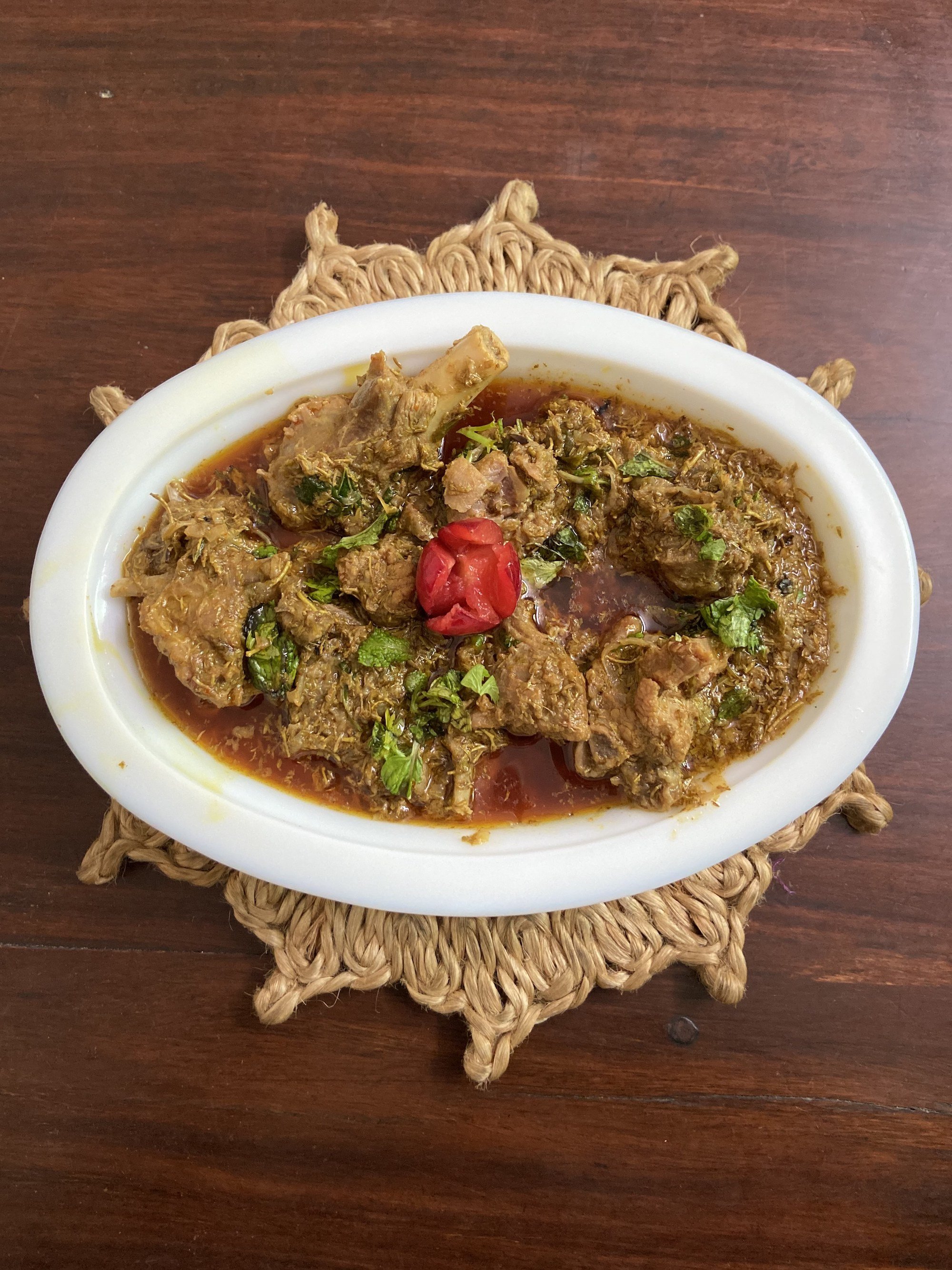Chugur ka Salan, Tangy Mutton Curry with Tender Tamarind Leaves

Mutton cooked with tender tamarind leaves is a dish that celebrates the coming of Spring, across the Deccan. The sour earthy flavour of tamarind leaves and the fatty breast of meat, is dish that is hearty, nourishing and soulful.
With the onset of spring, fresh tamarind shoots called chugur appear on tamarind trees, in refreshing shades of red, pink and green. Chugur Gosht ka Saalan, is a delicacy cooked as an annual ritual to celebrate and experience the change of season; the colours adding a splash of the season’s freshness to our tables. Even as chugur season is very short lived, with tender shoots beginning to lose their soft succulent texture, outgrowing their delicate character; kitchens in Deccan prepare these tangy tender leaves and flowers of the new shoots with mutton.
This saalan is a savoury treat. Local butchers in Hyderabad are well versed with the special cuts of meat meant specifically for cooking chugur. The choice of mutton cut varies; my family prefers the fats and juices of the seeney ka gosht – breast cut along with ribs, that contrasts and enriches the gentle sourness of chugur. Often, chugur is dried and used all year round; while some freeze the fresh harvest in order to recreate spring during other seasons. Another preparation uses dried Bombil (Bombay Duck) and green aubergines in place of mutton.
My childhood memories are interwoven with escapades around an old tamarind tree, in the compound of Nizam’s era-Lady Hyderi Club, Bashir Bagh, our favourite meeting place. In between games, pretending to be little sleuths, unravelling mysteries, we would jump high to bring down the branches of the tree, for a taste of the fresh shoots of chugur. It's tangy sourness better than any fancy candy, and the raw and ripened tamarind serving as lollipops.
The tamarind tree remains central to Hyderabad’s culinary landscape, and collective memory. The city was planned to accommodate dedicated green pastures and groves such as Imliban (tamarind groves), berban (jujube groves), kewraban (kewra shrubs), and aamrai (mango groves). The name Imliban on banks of river Musi exists even today, but without the tamarind grove. In 1908, Hyderabad saw one of its worst floods as the river Musi swelled, killing thousands, destroying bridges and buildings. One particular Tamarind tree, that still stands today at Osmania General Hospital, saved 150 people who climbed on to it till the flood waters receded. Hyderabad city lovingly honours this tree annually. The tamarind tree epitomises Hyderabad’s quintessential cuisine and its dateline with history and memory.
Chugur, or tender tamarind leaves
Chugur ghosht ka salan
Kitchens across communities in Deccan have used the rich tamarind fruit, raw or ripened imli, and its tender shoots, chugur, for preparing culinary delights to satisfy culinary connoisseurs. Deccan’s love for sourness, and passion for khatta, makes Hyderabad’s cuisine unique, drawing deeply from food cultures of peninsular India. The distinctive refinement that gave birth to Hyderabad’s cuisine can only be understood through its rich history and culture. The roots of many dishes are a legacy of the confluence of cultural and culinary heritage of Telangana, Marathwada, Turkic–Persian and Arab food cultures/subcultures. Chugur Gosht ka Saalan is one such dish that encapsulates a milieu of flavours and histories that are still savoured across Deccan.
Recipe for Chugur Gosht ka Salan
Serves: 4
Ingredients
1/2 kg mutton breast pieces, ribs and few marrow bones
2 full cups of chugur
3 to 4 medium sized onions- slice them.
4 to 5 green chillies
1/2 teaspoon ginger paste
1&1/2 teaspoon garlic paste
1/4 teaspoon turmeric powder
1 teaspoon red chilli powder
1/2 cup oil
3 to 4 cups of water
Salt, to taste
Method
Remove the hardened stems from the Chugur, use only tender leaves and flowers. Wash the chugur and then spread it to dry. After it is dry, gently crush the leaves with your fingers.
In a pan heat oil and add the sliced onions. When half done add ginger-garlic paste, turmeric and salt. Fry for sometime, add the mutton and fry. Add slit four chillies and the chilly powder. Add water and let it cook till the mutton, breast pieces and bones are tender. You can also pressure cook if you desire or simmer on medium heat allowing the fats and juices to blend together.
Add chugur to the mutton saalan and let it cook on medium heat. As we have already crushed the chugur, it will take very little time to cook. Cover it & cook the chugur till it becomes tender, oil surfaces and separates fully. Serve it hot with rice.
Fatima Zarafshan is an academic who has taught in India and the Middle East over the past four decades. She is currently exploring food cultures of the Deccan and trying to revisit old recipes of Hyderabad.
ALSO ON THE GOYA JOURNAL









